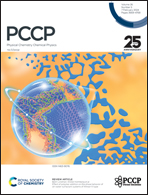Two-dimensional graphene+ as an anode material for calcium-ion batteries with ultra-high capacity: a first-principles study†
Abstract
Multivalent-ion batteries have garnered significant attention due to their high energy density, low cost, and superior safety. Calcium-ion batteries (CIBs) are regarded as the next-generation energy storage systems for their abundant natural resources and bivalent characteristics. However, the absence of high-performance anode materials poses a significant obstacle to the progress of battery technology. Two-dimensional (2D) Dirac materials have excellent conductivity and abundant active sites, rendering them promising candidates as anode materials. A novel 2D Dirac material known as “graphene+” has been theoretically reported, exhibiting prominent properties including good stability, exceptional ductility, and remarkable electronic conductivity. By using first-principles calculations, we systematically investigate the performance of graphene+ as an anode material for CIBs. Graphene+ exhibits an ultra-high theoretical capacity (1487.7 mA h g−1), a small diffusion barrier (0.21 eV), and a low average open-circuit voltage (0.51 V). Furthermore, we investigate the impact of the electrolyte solvation on the performance of Ca-ion adsorption and migration. Upon contact with electrolyte solvents, graphene+ exhibits strong adsorption strength and rapid migration of Ca-ions on its surface. These results demonstrate the promising potential of graphene+ as a high-performance anode material for CIBs.



 Please wait while we load your content...
Please wait while we load your content...